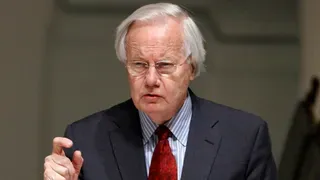December 28, 2012
Magic To Do :: Choreographer Chet Walker Conjures up Fosse for ART's 'Pippin'
Robert Nesti READ TIME: 7 MIN.
Mention "Fosse" and an image immediately comes to mind: an arched, lean body with arms and legs stretched, but a bit bent, as if coiled for action; a derby slightly tipped and a cigarette poised on the lips, dramatically back-lit to create a chiaroscuro effect. The image insinuates sexuality; but playfully, with tongue-firmly-in-cheek. And this is even before the dancer takes a step. With them comes slink with a wink - a potent combination that electrified Broadway from its start in the early 1950s with a number called "Steam Heat" and lasted right through Fosse's death in 1987.
Choreographer Chet Walker wasn't present for "Steam Heat" (he wasn't yet born), but was present during what he calls his "dark period" - the last 15 years of his life that went from "Pippin," in which Walker played in the chorus for two years, through "Chicago," "Dancin'," "Big Deal" and the revival of "Sweet Charity," which Fosse was supervising when he died in Washington DC. Walker also helped create "Fosse," a 1999 musical revue that celebrated the director/choreographer's career with recreations of his best work. Because of this close working relationship, Walker's become something of the go-to expert when it comes to all things Fosse. In 2011 he was asked to consult on a production of "Pippin" at London's Menier Chocolate Factory. Then when Diane Paulus was looking to find someone to choreograph a new production of that 1973 musical at the American Repertory Theater (where she is artistic director), she turned to Walker.
No major revivals
"Pippin" is a bit of an oddity - a largely plotless show that follows the career of the son of Charlmagne, as he struggles to find meaning to his life against the contentious political wranglings and social upheaval of Medieval France. Conceived by Stephen Schwartz as a student show at Carnegie-Mellon University, it was originally performed in the style of the composer/lyricist's "Godspell."
That was until Bob Fosse took over. By the time it got to Broadway, Schwartz and his book writer Roger O. Hirson were barred from the theater and their warmer approach to the material was replaced with something more cynical and menacing. Buoyed by a clever television ad, which featured star Ben Vereen and two of the dancers in a classic bit of Fosse choreography, the show became a huge hit, running nearly five years. The show wasn't filmed, but the original production was recorded for television, (It is available on Netflix.) Yet it remains one of the few big musicals from the 1970s not to have a major revival, something that Walker doesn't quite understand until now.
Heavier themes
"I don't think there's a simple answer to that," he explained recently before a performance. "I think when you ask people what they think of 'Pippin,' they say they love the album; but if you ask them what it is about, you draw a blank. Usually it's done in high schools and community theaters, but it doesn't get done professionally all that much. So people really don't know it. But it is heavy. It has a huge message - several huge messages. And I think Diane is talking to those issues. It will make you ponder and think. I think when the show was first done, those elements were present, but weren't really paid attention to. We are in a different time in theater history and the history of the country - of where we are and what see. We look at theater and things differently than we did in 1973, so these elements are more present."
When the show opened, Walker was performing at the nearby Lunt-Fontanne Theatre in an ill-fated revival of "The Pajama Game," a show that was Fosse's first Broadway success. (It contained the aforementioned "Steam Heat.") Just barely twenty, he came to "Pippin" in a round-about way. When audition notices were posted for Fosse's next show, "Chicago," Walker auditioned, but didn't get cast; instead he went into "Pippin" mid-way through its five year Broadway run.
Fosse’s greatness
Having worked with Fosse so closely, what does he think is the key to his greatness?
"I think that he was a very misunderstood person. I think that people that are misunderstood keep trying to be heard or understood. And he never gave up on that. That is what makes someone great - they don't settle on what other people think that they are. They are constantly searching - constantly exploring the possibilities. I think that people that keep moving forward are great artists. I remember five minutes before his passing, he was still coming up with ideas. What if we did this... what if we could? That is someone who is open and always wanting to make things better.
"What also makes him a great artist is that he is a performer and a writer. He understood the concepts. He was a wonderful writer - he was the original writer for 'Sweet Charity' under the name Robert Lewis. There was so much that he did and so much he wanted to know."
Add acrobats
"Pippin" is set in a circus-like atmosphere, with a master-of-ceremonies (called the Leading Player) conjuring up a fantastical world in the opening number "Magic To Do." In this production, Paulus takes it one step further by utilizing the talents of the Montreal-based dance company Les 7 Doigts de la Main for the acrobatic effects. The advance word is that they are both stunning and seamlessly integrated in the movement; but at first Walker was a bit skeptical.
"In the beginning, I wasn't sure if it could work. But like Mr. Fosse, you look at the elements and find ways to make them work. And it works really, really well. It was an unknown, now it's a known. And it is great."
Full-circle
In the end, though, the working on this production brought Walker full-circle, back to 1973 when he first saw the show. "As I said to Mr. Schwartz the other day that it was the first show that I thought was about a young person - like me. I totally related to 'Pippin' in so many different ways. And I think that is what makes this version of a young man's life so exciting. We hit all the possibilities. We ask the audience too: Which side of the fence do you sit on? And can you see both sides? I think our job is to show that and I think this production does that. This is a profound journey of a young man's life. All that watch it can relate to him - they don't have to be him or relate to his situation. And what is great about this show is that it is timeless. We still have the same issues the show addresses."
As for working with Paulus, Walker (who also directs) is impressed by her vision and technique. "As a director, you are constantly trying to find new ways of doing things, and it's been great to watch the way she works and discovers things. The way she allows things to evolve, then evolve again; then move onto the next thing. She's quite an amazing director. She has her eyes open to everything. She's an amazing story-teller. It has made me look back to some of the work I've done as a director and wonder, did I tell that story as well? I am constantly learning."
"Pippin" continues through Jan. 20, 2013 at the Loeb Drama Center, 64 Brattle Street, Cambridge, MA. For more information, visit the American Repertory Theater website.
Robert Nesti can be reached at [email protected].





